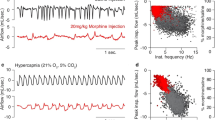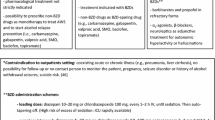Abstract
Parenteral administration of the adenosine deaminase (ADA) inhibitor erythro-9-(2-hydroxy-3-nonyl)-adenine (EHNA) results in a profound decrease in spontaneous motor activity in mice and rats. The inhibition of cortical ADA activity measured ex vivo parallels the decrease in spontaneous motor activity in a time-dependent manner. Nonetheless, a marked reduction in electroencephalographically defined sleep was observed in rats during a period when both spontaneous motor activity and ADA activity were profoundly inhibited. These data suggest that EHNA produces in rats a state of ‘quiescent waking’, which may be related to the observed inhibition of brain ADA activity.
Similar content being viewed by others
References
Bruns R, Daly J, Snyder S (1980) Adenosine receptors in brain membranes: Binding of N6-cyclohexyl-[3H]-adenosine and 1,3-diethyl-8-diphenyl-xanthine. Proc Natl Acad Sci USA 77:5547–5551
Crawley J, Patel J, Marangos P (1981) Behavioral characterization of two long-lasting adenosine analogs: Sedative properties and interaction with diazepam. Life Sci 29:2623–2630
Daly J (1982) Adenosine receptors: Targets for future drugs. J Med Chem 25:197–207
Haulica I, Ababei L, Branisteanu D, Topoliceanu F (1973) Preliminary data on the possible hypnogenic role of adenosine. J Neurochem 21:1019–1020
King C, Masserano JM, Codd E, Byrne WL (1981) Effects of beta-endorphin and morphine on the sleep-wakefulness behavior of cats. Sleep 4:259–262
Maitre M, Ciesielski L, Lehmann A, Kempf E, Mandel P (1974) Protective effect of adenosine and nicotinamide against audiogenic seizure. Biochem Pharmacol 23:2807–2816
Mendelson W, Guthrie R, Frederick G, Wyatt R (1974) An evaluation of the ‘flower pot method’ of REM sleep deprivation. Pharmacol Biochem Behav 2:553–556
Mendelson W, Majchrowicz E, Mirmirani N, Dawson S, Gillin JC, Wyatt RJ (1978) Sleep during chronic ethanol administration and withdrawal in rats. J Stud Alcohol 39:1213–1223
Mustafa S, Tewari C (1970) Latent adenosine deaminase in mouse brain. II. Purification and properties of mitochondrial and supernatant adenosine deamines. Biochem Biophys Acta 220:326–337
Okada Y, Kuroda Y (1980) Inhibitory action of adenosine and adenosine analogs on neurotransmission in the olfactory cortex slice of guinea pig: Structure-activity relationships. Eur J Pharmacol 6:137–146
Okada Y, Ozawa S (1980) Inhibitory action of adenosine on synaptic transmission in the hippocampus of the guinea pig in vitro. Eur J Pharmacol 68:483–492
Phillis J, Edstrom J (1976) Effects of adenosine analogs on rat cerebral cortical neurons. Life Sci 19:1041–1054
Pull I, McIlwain H (1975) Rat cerebral-cortex adenosine deaminase activity and its subcellular distribution. Biochem J 144:37–41
Schwabe U, Trost T (1980) Characterization of adenosine receptors in rat brain by (-)[3H]N6-phenylisopropyladenosine. Naunyn-Schmiedeberg's Arch Pharmacol 313:179–187
Shimizu H, Daly J, Creveling C (1969) A radioisotopic method for measuring the formation of adenosine 3′,5′-cyclic monophosphate in incubated slices of brain. J Neurochem 16:1609–1619
Skolnick P, Nimitkitpaisan Y, Stalvey L, Daly J (1978) Inhibition of brain adenosine deaminase by 2′-deoxycoformycin and erythro-9-(2-hydroxy-3-nonyl)-adenine. J Neurochem 30:1579–1582
Snyder S, Katims J, Annau Z, Bruns R, Daly J (1981) Adenosine receptors and behavioral actions of methylxanthines. Proc Natl Acad Sci USA 78:3260–3264
Stone T (1981) Physiological roles for adenosine and adenosine 5′-triphosphate in the nervous system. Neuroscience 6:523–556
Williams M, Risley E (1980) Biochemical characterization of putative central purinergic receptors by using 2-chloro-[3H]-adenosine, a stable analog of adenosine. Proc Natl Acad Sci USA 77:6892–6896
Author information
Authors and Affiliations
Rights and permissions
About this article
Cite this article
Mendelson, W.B., Kuruvilla, A., Watlington, T. et al. Sedative and electroencephalographic actions of erythro-9-(2-hydroxy-3-nonyl)-adenine (EHNA): Relationship to inhibition of brain adenosine deaminase. Psychopharmacology 79, 126–129 (1983). https://doi.org/10.1007/BF00427798
Received:
Accepted:
Issue Date:
DOI: https://doi.org/10.1007/BF00427798




